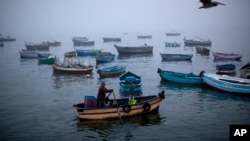Thousands of Chilean fishermen blocked roads with barricades in the region of Los Lagos on Monday and Tuesday, saying government efforts to mitigate the economic effects of a harmful algal bloom have been insufficient.
For the last four weeks, the southern-central region of Los Lagos has been plagued by what scientists say is the biggest "red tide" in its history.
The red tide - an algal bloom that turns the sea water red - is a common, naturally recurring phenomenon in southern Chile, though the extent of the current outbreak is unprecedented.
Scientists point to an unusually strong El Nino weather pattern this year as a key factor.
It makes the mussels, hake, and other fish that residents pull from the ocean essentially poisonous, heaping economic pressure on a region with tens of thousands of artisanal fishermen.
In one instance, protesters took over a principal access ramp to the island of Chiloe.
The government has offered to pay each affected family 100,000 pesos ($151) each in compensation, an amount fishermen have widely rejected as insufficient.
"What the government announced is not going to work for us," said fisherwoman Doris Santana. "In no way can we live on 100,000 pesos."
Artisanal fishing unions have blamed the size of the red tide on pollution by Chile's farmed salmon industry, which is active in the Los Lagos region.
However, Chile's SERNAPESCA fisheries body as well as many scientists have rejected that explanation, pointing to natural factors such as the cyclical El Nino weather pattern, which warms part of the Pacific Ocean and has also caused heavy rain and flooding elsewhere in the region.
"What we are having here is a silent catastrophe, one that affects a lot of people and a vast territory," said Leonardo de la Prida Sanhueza, the regional governor.





